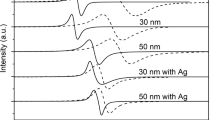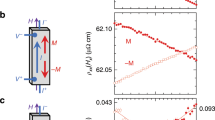Abstract
An effect whereby an anisotropic magnetic material acquires a remanence on exposure to an alternating magnetic field (a.f.) is predicted from an analysis of the phenomenon of rotational remanent magnetisation (RRM). The remanence, which is of gyromagnetic origin, is produced even when there is no relative rotation between sample and field and all constant fields have been eliminated. The effect is demonstrated in magnetic recording tape and, as well as having important implications for a.f. demagnetisation techniques, may be relevant to magnetic recording processes.
This is a preview of subscription content, access via your institution
Access options
Subscribe to this journal
Receive 51 print issues and online access
$199.00 per year
only $3.90 per issue
Buy this article
- Purchase on Springer Link
- Instant access to full article PDF
Prices may be subject to local taxes which are calculated during checkout
Similar content being viewed by others
References
Bates, L. F. Modern Magnetism 4th edn (Cambridge University Press, 1963).
Stephenson, A. Geophys. J. R. astr. Soc. (in the press).
Stephenson, A. Nature 284, 48–49 (1980).
Wilson, R. L. & Lomax, R. Geophys. J. R. astr. Soc. 30, 295–303 (1972).
Bate, G. & Williams, J. A. IEEE Trans. Mag. 5, 869–870 (1978).
Author information
Authors and Affiliations
Rights and permissions
About this article
Cite this article
Stephenson, A. A gyroremanent magnetisation in anisotropic magnetic material. Nature 284, 49–51 (1980). https://doi.org/10.1038/284049a0
Received:
Accepted:
Issue Date:
DOI: https://doi.org/10.1038/284049a0
This article is cited by
-
Anisotropy of magnetic remanence: A brief review of mineralogical sources, physical origins, and geological applications, and comparison with susceptibility anisotropy
Pure and Applied Geophysics PAGEOPH (1991)
Comments
By submitting a comment you agree to abide by our Terms and Community Guidelines. If you find something abusive or that does not comply with our terms or guidelines please flag it as inappropriate.



